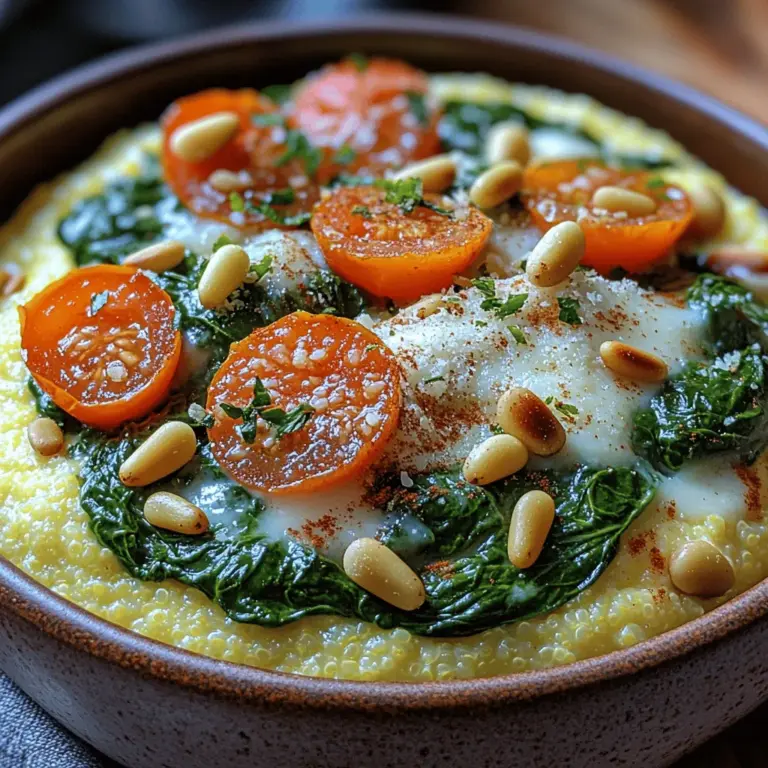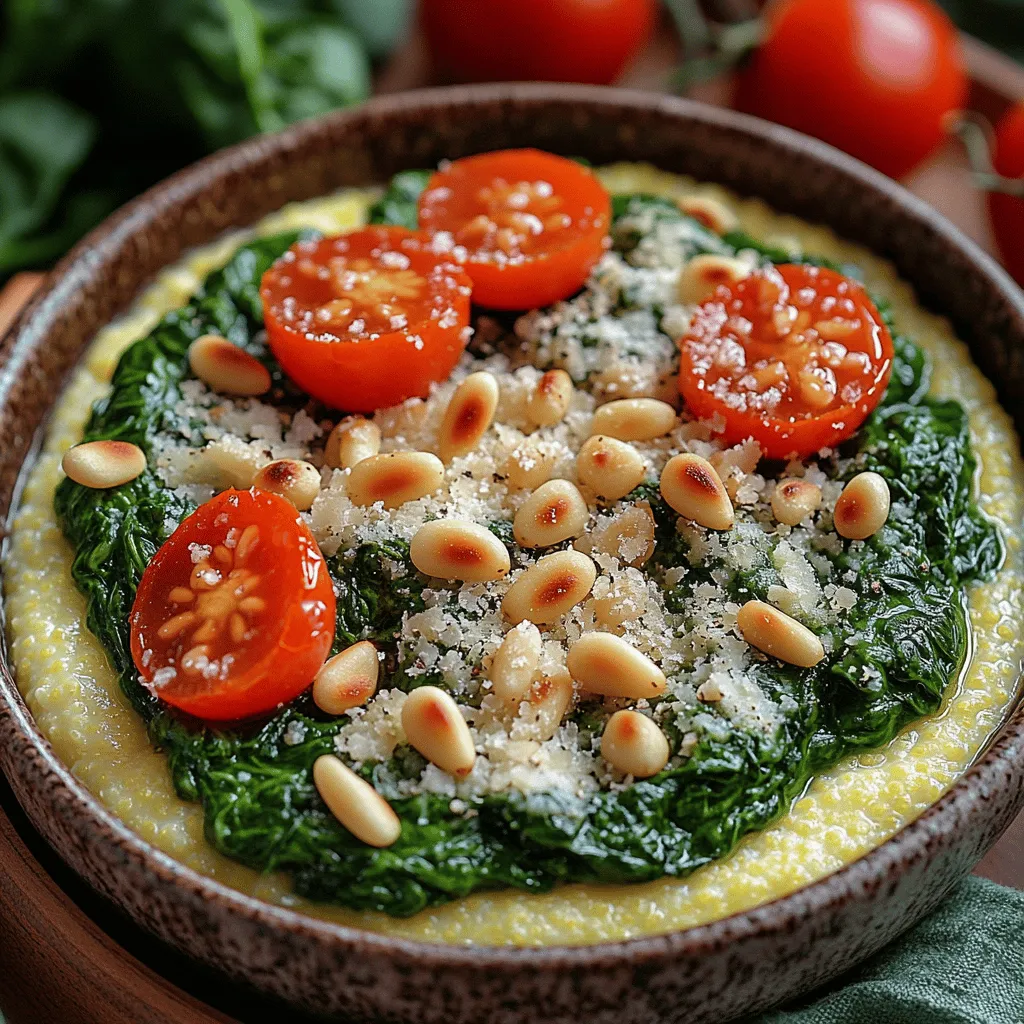Introduction
Polenta, a dish made from ground cornmeal, has been a staple in Italian cuisine for centuries. Its creamy texture and mild flavor make it a versatile base for a variety of toppings, inspiring chefs and home cooks to experiment with it in countless ways. Among the many delightful creations that feature polenta, Creamy Spinach Polenta Bowls stand out as a nourishing and comforting meal suitable for any occasion. This dish embraces the essence of comfort food, combining the rich creaminess of polenta with the vibrant flavors of sautéed spinach, resulting in a dish that is not only satisfying but also visually appealing.
What makes these Creamy Spinach Polenta Bowls even more enticing is their adaptability. Whether you’re following a vegan or vegetarian diet, this recipe can cater to your dietary preferences without compromising on taste. Packed with nutrients and flavor, it serves as an excellent choice for a hearty lunch, a light dinner, or a side dish that will impress your guests.
Understanding Polenta
Definition and Origin of Polenta
Polenta is a traditional Italian dish made from coarsely ground cornmeal. Its origins can be traced back to ancient times, when it was consumed as a staple food by the Romans. What was once considered peasant food has evolved into a beloved dish, enjoyed in various forms throughout Italy and beyond. Depending on the region, polenta can be served soft and creamy, or allowed to cool and solidify into a cake that can be sliced and grilled or fried.
Polenta is not only a versatile ingredient but also a blank canvas for flavors, allowing it to seamlessly adopt the characteristics of whatever ingredients are paired with it. Its adaptability makes polenta an excellent choice for those looking to create both savory and sweet dishes, from breakfast to dessert.
Nutritional Benefits of Polenta
One of the appealing aspects of polenta is its nutritional profile. It is gluten-free, making it an excellent option for those with gluten sensitivities or celiac disease. Polenta is primarily composed of carbohydrates, providing a good source of energy. It is also low in fat and contains essential vitamins and minerals, including vitamin A, vitamin B, and iron.
Moreover, polenta is a good source of fiber, which is vital for digestive health. When prepared with nutrient-rich broth and combined with fresh vegetables like spinach, polenta can be transformed into a well-rounded meal that nourishes the body.
The Versatility of Polenta in Various Cuisines
Polenta’s versatility extends beyond Italian cuisine; it has found its way into various culinary traditions around the world. In South America, a similar dish called “arepas” is made using cornmeal and served with diverse fillings. In Southern U.S. cooking, polenta is often used in place of grits, showcasing its adaptability to regional flavors.
From breakfast bowls topped with eggs and avocado to savory mains layered with roasted vegetables and sauces, polenta can be customized to suit any meal. This flexibility is part of what makes Creamy Spinach Polenta Bowls such a delightful dish—they can be enjoyed as a simple weekday meal or dressed up for entertaining guests.
Ingredients Breakdown
To prepare Creamy Spinach Polenta Bowls, it is essential to gather a few key ingredients that will elevate the dish’s flavor and texture. Below is an overview of the essential components you will need:
Overview of Essential Ingredients for Creamy Spinach Polenta Bowls
1. Polenta: The star of this dish, polenta serves as the creamy base. You can use either quick-cooking or traditional polenta, depending on the time you have available.
2. Vegetable Broth or Water: The liquid used to cook polenta significantly impacts its flavor. Using vegetable broth instead of water enhances the overall taste and adds depth to the dish.
3. Fresh Spinach: This leafy green is packed with vitamins and minerals, adding a pop of color and nutritional value to your bowl.
4. Garlic: Fresh garlic lends a robust flavor to the dish, complementing the spinach and polenta beautifully.
5. Dairy Alternatives: Depending on your dietary preference, you can use heavy cream for a rich texture or coconut cream for a dairy-free option.
6. Nutritional Yeast: This ingredient provides a cheesy flavor without the use of dairy, making it an excellent choice for vegans.
7. Spices: Basic seasoning with salt, pepper, and a hint of nutmeg enhances the dish without overpowering the natural flavors.
Detailed Description of Polenta
Polenta is made from yellow cornmeal, which can vary in grind size from coarse to fine. The texture you choose will influence the cooking time and the final mouthfeel of the dish. Coarse polenta takes longer to cook but offers a heartier texture, while finer varieties cook more quickly and yield a creamier consistency.
When cooking polenta, it’s crucial to use the right ratio of liquid to cornmeal, typically around 4:1 for a creamy texture. The cooking process involves stirring the mixture constantly to prevent lumps from forming, resulting in an even and smooth consistency.
Benefits of Using Vegetable Broth vs. Water
While water can certainly be used to cook polenta, opting for vegetable broth adds a layer of flavor that enhances the overall dish. Broth infuses the polenta with savory notes, making it more enjoyable on its own without the need for excessive seasoning. Additionally, using broth can enrich the nutritional content, as it often contains a variety of vegetables and herbs that contribute vitamins and minerals.
Importance of Fresh Ingredients: Garlic and Spinach
Using fresh ingredients is crucial in achieving the best flavor in your Creamy Spinach Polenta Bowls. Fresh garlic not only adds depth but also offers health benefits, including anti-inflammatory properties and enhanced immune support. Spinach, when fresh, retains its vibrant color and nutrients, making it a perfect complement to the creamy polenta. Opting for fresh spinach over frozen will ensure that your dish has the best taste and texture.
Exploring Dairy Alternatives: Heavy Cream vs. Coconut Cream
For those avoiding dairy, there are excellent alternatives that can be used to achieve a creamy texture in polenta. Heavy cream provides a luxurious richness, while coconut cream offers a subtly sweet flavor profile that pairs well with the earthiness of the polenta and spinach. Coconut cream is also an excellent option for vegans or lactose-intolerant individuals, ensuring that everyone can enjoy this comforting dish without compromise.
Nutritional Yeast as a Cheese Substitute for Vegan Diets
Nutritional yeast is a popular ingredient in vegan cooking that can impart a cheesy flavor to dishes without the need for dairy. It is rich in vitamins, including B12, and is often fortified to enhance its nutritional profile. Incorporating nutritional yeast into your Creamy Spinach Polenta Bowls will provide that savory, cheesy taste that many crave while keeping the dish entirely plant-based.
Role of Spices: Salt, Pepper, and Nutmeg
Seasoning is essential to bring out the best flavors in any dish. For Creamy Spinach Polenta Bowls, a simple combination of salt, pepper, and a touch of nutmeg enhances the dish without overpowering the natural ingredients. The nutmeg adds a subtle warmth and depth that complements the creaminess of the polenta and the freshness of the spinach, creating a harmonious balance of flavors.
Step-by-Step Cooking Instructions
Now that you have a clear understanding of the ingredients, it’s time to dive into the cooking process. Preparing Creamy Spinach Polenta Bowls involves a few simple steps that will guide you to culinary success.
Cooking the Polenta: Achieving the Perfect Texture
1. Gather Your Ingredients: Start by assembling all of your ingredients and measuring out the required amounts. This will streamline the cooking process and ensure that you don’t miss any components.
2. Boil the Liquid: In a medium saucepan, bring your vegetable broth or water to a boil over medium-high heat. This step is crucial as it will create the base for your polenta.
3. Gradually Add the Polenta: Once the liquid is boiling, reduce the heat to low and slowly whisk in the polenta. It’s essential to add the polenta gradually while whisking continuously to prevent lumps from forming.
4. Stir Constantly: Once the polenta has been added, continue to stir constantly. This is key to achieving that creamy texture. If you stop stirring, the polenta can clump together and lead to an undesirable grainy consistency.
5. Cook Until Thickened: Allow the polenta to cook for about 20-30 minutes, maintaining a gentle simmer. The polenta will thicken as it cooks, and it should pull away from the sides of the pan when it’s ready.
6. Adjust Consistency: If the polenta is too thick, feel free to incorporate a bit more broth or water until you reach your desired consistency. The goal is to achieve a creamy, smooth texture that can hold its shape while still being spoonable.
7. Add Flavorings: Once the polenta has reached the desired texture, stir in your choice of heavy cream or coconut cream for added richness. If you’re using nutritional yeast, this is the perfect time to mix it in, along with your spices—salt, pepper, and nutmeg.
Importance of Constant Stirring
Stirring constantly is not just a suggestion; it’s a necessity when cooking polenta. This technique prevents lumps from forming and ensures that the polenta cooks evenly. It also helps to release the starches from the cornmeal, contributing to that creamy texture that makes polenta so appealing. If you find your arm getting tired, consider using a sturdy whisk or a wooden spoon to make the process easier.
Tips for Avoiding Lumps
If you’re new to cooking polenta, you might be concerned about ending up with a lumpy final product. Here are a few tips to help you achieve a smooth consistency:
– Use a Whisk: A whisk is your best friend when it comes to mixing polenta. It helps break up any clumps that may form while incorporating the cornmeal into the liquid.
– Add Polenta Slowly: Adding the polenta gradually allows it to absorb the liquid evenly, reducing the chances of lumps.
– Keep the Heat Low: Cooking polenta over low heat while stirring constantly allows for gradual thickening, which helps prevent lumps from forming.
Following these instructions will set you on the right path to creating delicious Creamy Spinach Polenta Bowls that are not only comforting but also packed with flavor and nutrients. In the next part of this article, we will explore the sautéing of spinach and garlic, as well as how to assemble your polenta bowls for a beautifully presented meal.



